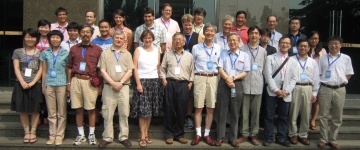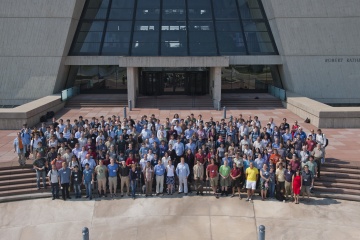Image of the week
Super scientists stand symmetricallyParticipants in the SUSY 2011 conference held from 28 August to 3 September at Fermilab. |
In the News
-
from New Scientist7 September 2011The new result comes from an experiment called CRESST II which uses a few dozen supercooled calcium tungstate crystals to hunt for dark matter from deep beneath the Gran Sasso mountain in Italy.
-
from BBC News7 September 2011Researchers at the Cresst experiment in Italy say they have spotted 67 events in their detectors that may be caused by dark matter particles called Wimps.
-
from NPR6 September 2011The Tevatron has been the pride of the Fermi National Accelerator Laboratory for a quarter of a century. But at the end of this month the Tevatron is shutting down.
-
from New Scientist6 September 2011Antimatter enthusiasts will love it; dark matter hunters not so much. NASA’s FERMI satellite has confirmed a previous hint that there is more antimatter than expected coming from space. The bad news is that the result almost certainly rules out dark matter as the source.
-
from Reuters5 September 2011U.S.-based physicists said on Monday they hope to have enough data by the end of this month to establish if the elusive Higgs boson a particle thought to have made the universe possible exists in its long-predicted form.
-
from SLAC31 August 2011Branded “temporary” when they were built in 1966 and threatened with demolition more than once during the past 35 years the dozen portable classroom buildings and office trailers known as “PEP City” are being torn down this week.
-
from msnbc.com31 August 2011The latest results from the Large Hadron Collider serve as a reality check for expectations that radical scientific discoveries are just around the corner.
-
from National Geographic31 August 2011The mysterious substance known as dark matter may actually be an illusion created by gravitational interactions between short-lived particles of matter and antimatter a new study says.
Copyright © 2026 ILC International Development Team




